Thomas Nast
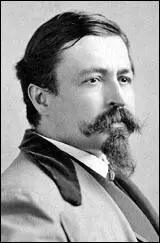
Thomas Nast was born in Landau, Germany, on 27th September, 1840. His father, a musician, had radical political views and found the conservative Bavarian government oppressive. He therefore decided to take his family to the United States.
Nast was raised in New York City and at the age of 15 had his first drawing published by a national magazine. Inspired by the cartoons of John Leech and John Tenniel, in 1855 Nast started working for Leslie's Illustrated Newspaper.
As soon as Harper's Weekly was launched in 1857, Nast became determined to join the magazine. He had some drawings in the magazine but he did not obtain a full-time post until 1862.
Nast was a staunch opponent of slavery and throughout the Civil War Nast produced patriotic drawings urging people to help crush the rebels. Abraham Lincoln is reported to have said: "Thomas Nast has been our best recruiting sergeant. His emblematic cartoons have never failed to arouse enthusiasm and patriotism."
After the war Nast remained a strong supporter of black civil rights and some of his cartoons attacked Andrew Johnson for undermining Lincoln's policies. During this period Nast began to distort and exaggerate the physical traits of his subjects and therefore played an important role in the development of political caricature.
Nast also originated the idea in America of using animals to represent political parties. In his cartoons the Democratic Party was a donkey and the Republican Party, an elephant. He also helped to develop the character, Uncle Sam, to represent the United States.
Thomas Nast, caused great controversy with his cartoon This is a White Man's Government! (September 1868). It showed from left to right a stereotyped Irishman (representing a Northern Democratic party member), an ex- Confederate soldier (Nathan B. Forrest) (representing a Southern Democratic party member), and a Chief of the Democratic party financier (August Belmont) "triumphing" over a prostrate Union Army soldier on the ground.
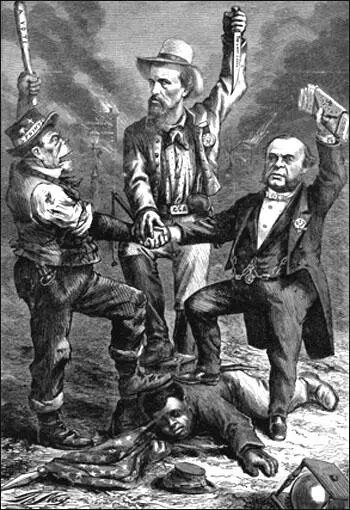
In September 1869, Nast began his campaign in Harper's Weekly against William Tweed, the corrupt political leader of New York City. Pressure was put on Harper Brothers, the company that produced the magazine, and when it refused to sack Nast, the company lost the contract to provide New York schools with books. Nast himself was offered a bribe of $500,000 to end his campaign. This was hundred times the salary of $5,000 that the magazine paid him but Nast still refused and eventually Tweed was arrested and imprisoned for corruption. Nast's campaign against Tweed was later described as "the finest and most effective political cartooning ever done in the United States."
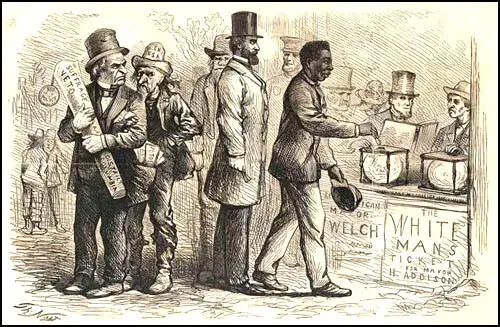
A strong Republican Party supporter, Nast supported Ulysses Grant in 1868 against his rivals, Horace Greeley and Horatio Seymour. Grant's next opponent, Samuel Tilden, had helped Nast remove William Tweed from office. However, Nast continued to use his skill as an artist to undermine Tilden and helped Grant achieve another victory.
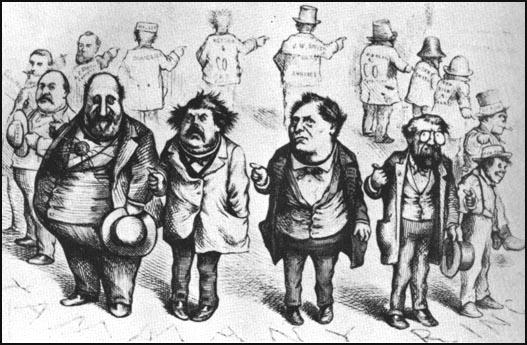
Sweeney, Richard Connolly and Oakley Hall that appeared in Harper's Weekly (19th August, 1871)
Thomas Nast was accused of being hostile the Irish, and Catholics. Frances Mulraney pointed out: "It cannot be disputed that Thomas Nast was a skilled, creative artist of historical significance. He is often considered the ‘Father of the Editorial Cartoon' and is credited with the creation of the symbolism of Columbia, the Republican Party Elephant and the popular image of Santa Claus. However, Nast was also the creator and perpetrator of numerous bigoted stereotypes targeting Irish and Catholic Americans. The hateful bigotry manifested in Nast's frequent depictions of Irish Americans as violent apes are commonly used in school curricula as prime examples of anti-immigrant nativism. There is no nuance in Nast's depictions of Irish Americans and Catholics that would lead any reasonable person to a benign interpretation."
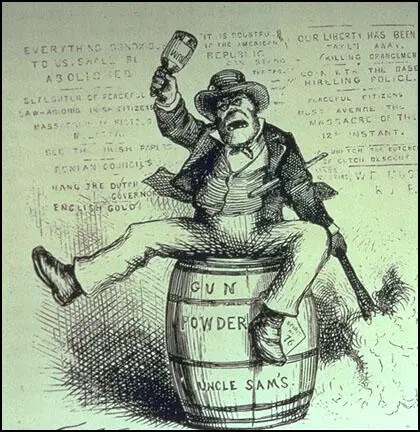
Thomas Nast was also a campaigner for Native American rights. On 27th April, 1871, he published a cartoon Move on! Has the Native American no rights that the naturalized American is bound to respect? Nast is making the point that Native Americans did not have the right to be represented while naturalized foreigners had the vote.
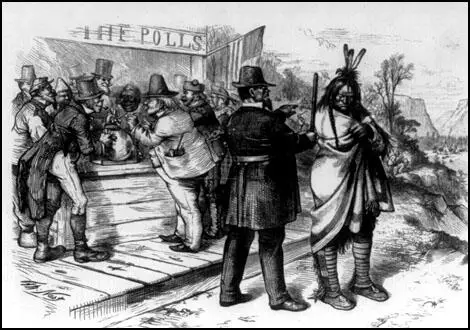
Thomas Nast was a constant critic of the Ku Klux Klan. The first branch of the KKK was established in Pulaski, Tennessee, in May, 1866. A year later a general organization of local Klans was established in Nashville in April, 1867. Most of the leaders were former members of the Confederate Army and the first Grand Wizard was Nathan Forrest, an outstanding general during the American Civil War. During the next two years Klansmen wearing masks, white cardboard hats and draped in white sheets, tortured and killed black Americans and sympathetic whites. Immigrants, who they blamed for the election of Radical Republicans, were also targets of their hatred. Between 1868 and 1870 the Ku Klux Klan played an important role in restoring white rule in North Carolina, Tennessee and Georgia.
Radical Republicans in Congress such as Benjamin Butler urged President Ulysses S. Grant to take action against the Ku Klux Klan. In 1870 he instigated an investigation into the organization and the following year a Grand Jury reported that: "There has existed since 1868, in many counties of the state, an organization known as the Ku Klux Klan, or Invisible Empire of the South, which embraces in its membership a large proportion of the white population of every profession and class. The Klan has a constitution and bylaws, which provides, among other things, that each member shall furnish himself with a pistol, a Ku Klux gown and a signal instrument. The operations of the Klan are executed in the night and are invariably directed against members of the Republican Party. The Klan is inflicting summary vengeance on the colored citizens of these citizens by breaking into their houses at the dead of night, dragging them from their beds, torturing them in the most inhuman manner, and in many instances murdering."

Thomas Nast also played an important role in securing victory for Rutherhood Hayes in 1876. Afterwards Hayes commented that Nast was "the most powerful single-handed aid we had."
In 1884 Nast changed sides and supported the Democratic candidate, Grover Cleveland for president. In doing so, he helped Cleveland become the first Democrat president since 1856. After this, Nast was known as the "presidential maker".
In the 1880s Nast's cartoons began to attack trade unions and the Catholic Church. This was less popular with his readers and after a disagreement with the owners of Harper's Weekly, left the journal in 1886. He started his own journal, Nast's Weekly, but it failed and he was left with heavy debts.
Other investments Nast made were also unsuccessful and he got into severe financial difficulties. Nast's cartoon work began to dry up and in 1902, President Theodore Roosevelt helped his old friend by appointing him U.S. consul in Ecuador. This provided him with a steady source of income until his death from yellow fever on 7th December, 1902.
Primary Sources
(1) Frances Mulraney, Irish Central (10th January, 2019)
The Thomas Nast Award for Best Cartoons on International Affairs is no more, as a review of Nast's attitudes toward immigrants, the Irish, and Catholics, caused the Overseas Press Club of America to change the name of the prize.
Since 1978, the award from the OPC has been named for the influential 19th-century American cartoonist but as Irish groups highlighted the anti-Irish bias Nast displayed throughout his work, the Board of Governors felt that his cartoons that "exhibited an ugly bias against immigrants, the Irish and Catholics" were not in line with the ideals of the prize.
"The Board had a thoughtful and robust conversation regarding the issues brought to light regarding some of Thomas Nast's editorial cartoons," said OPC President Pancho Bernasconi.
"Once we became aware of how some groups and ethnicities were portrayed in a manner that is not consistent with how journalists work and view their role today, we voted to remove his name from the award."
The move was commended by the Ancient Order of Hibernians, who were among those to push for the change.
"The Overseas Press Club and their President Pancho Bernasconi are to be commended for their reevaluation of the totality of Nast's legacy, their sensitivity, and their continuing commitment to promoting the highest ideals of journalism," the AOH said in a statement.
"It cannot be disputed that Thomas Nast was a skilled, creative artist of historical significance. He is often considered the ‘Father of the Editorial Cartoon' and is credited with the creation of the symbolism of Columbia, the Republican Party Elephant and the popular image of Santa Claus.
"However, Nast was also the creator and perpetrator of numerous bigoted stereotypes targeting Irish and Catholic Americans. The hateful bigotry manifested in Nast's frequent depictions of Irish Americans as violent apes are commonly used in school curricula as prime examples of anti-immigrant nativism. There is no nuance in Nast's depictions of Irish Americans and Catholics that would lead any reasonable person to a benign interpretation.
"It is disappointing that apologists for Nast often dismiss his detestable depictions of the Irish and Catholics as a minor idiosyncrasy, or worse yet indulge in the same defaming Irish stereotypes in attempts to justify Nast's despicable imagery," the statement continued.

